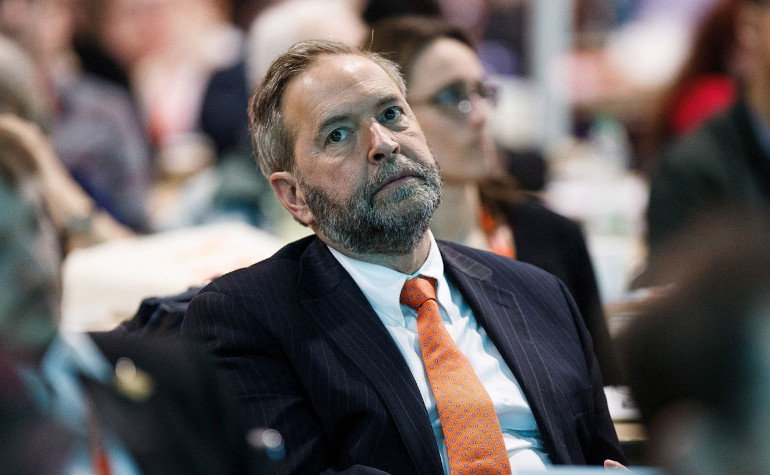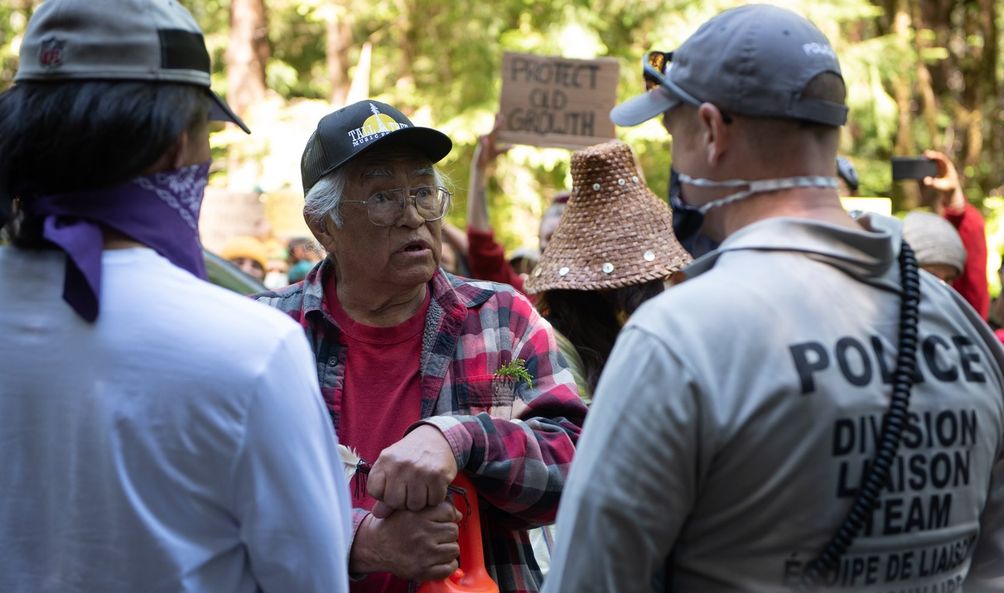Since winning a majority in the May 2011 federal election, the Conservative Party has continued its neo-liberal attacks. There is widespread opposition to these attacks. The New Democratic Party (NDP), the official opposition for the first time, has an historic opportunity to build a movement, based on campaigning around an alternative vision for society. If the NDP actively worked to defend workers and the environment, it could lay the foundation for a majority NDP government.
The NDP needs to show that it opposes, inside and outside of Parliament, the Tories’ continuing attacks on First Nations, the environment, jobs, social services, science, women’s rights, etc. This alternative would be based on shifting Canada away from neo-liberalism, at the provincial and federal level. However, the NDP has continued to move in the opposite direction.
In recent years, the NDP has moved to the right thinking that this would be more desirable to Canadian voters. Thomas Mulcair, who won the leadership race in 2012 with 57%, was the most moderate of the final four contenders in the race. Mulcair’s victory did not represent a dramatic shift to the right, but rather a continuation of past trends. As we predicted two years ago, the NDP has continued to shift to the right, dropping references to democratic socialism in the preamble to its constitution one year ago. [link]
The party’s shift to the right has not resulted in increased support for the NDP. Instead, the party lost provincial elections in British Columbia and Nova Scotia and failed to win any seats in the recent federal by-elections.
Dropping Democratic Socialism
In April 2013, the NDP voted to remove its commitment to “democratic socialism” from the preamble to its constitution. The vote concluded a debate, begun in 2011, in which the party’s then federal leader Jack Layton argued that it was part of refining and modernizing the language to describe NDP values. At the time Pat Martin, NDP MP for Winnipeg South, described the existing language as an “anchor” dragging down the party’s electability and argued that a few changes were required so that the NDP would not “scare people.”
Along the same lines newly elected party president Brian Topp said the proposed changes were purely symbolic, “We need to speak to the mainstream without becoming the Liberal Party. We need to balance being a progressive alternative with one that the public will trust with their wallets.”
Not all MPs supported changing the language.Libby Davies, NDP MP for Vancouver East argued that the proposed changes would dilute the party’s core principles saying, “We are not the Liberal Party, we are the NDP. We have a broad appeal but it’s based on the history of our party and what we stand for.”
However, at the 2013 NDP conference in Montreal, delegates voted 960 to 188 in favour of removing the party’s commitment to democratic socialism replacing it with a new preamble full of vague platitudes. It describes Canada as “a great country, one of the hopes of the world,” but what about Canada’s ruthless mining companies, its ongoing colonialism and imperialism, not to mention the everyday struggles of its working people? Mulcair applauded the vote saying that the changes would help the party better communicate its values to voters, reach out beyond the party’s traditional base, and that they were essential in defeating Stephen Harper.
Only sixteen percent of the convention delegates voted to retain the commitment to democratic socialism in the preamble. The NDP’s socialist caucus celebrated this result as a strong indication of interest in socialism inside the party. However, a crushing defeat is a crushing defeat. The socialist caucus failed to organize a campaign inside and outside the party around the retention of party’s original preamble. Such a campaign could have spread and galvanized support for democratic socialism, not only in words but also for what democratic socialism really means.
Indeed, the NDP vote was a symbolic gesture as it confirmed the NDP’s trajectory in recent decades. The NDP has become a party focused on parliament and elections, rather than campaigning in the community and workplaces for greater equality. Despite its radical history, it has been decades since the NDP challenged the rule of capital. The NDP of today is not interested in eliminating poverty, just reducing it. As such, the changes to the preamble were an important, symbolic confirmation of the transformation of the NDP. It is symbolic of a lost opportunity to build a party that would represent working people, the poor and the oppressed.
Few Canadians read the NDP’s preamble. What is more significant is the position the NDP has taken on everyday issues. However, the change in the preamble indicates the character of the position the NDP takes on these issues.
Free Trade & Progressive Taxation
In October 2013, two events showed the NDP capitulation to neoliberal capitalism: the party’s support for a major corporate free trade agreement, and its opposition to an International Monetary Fund (IMF) call for more progressive taxation. The NDP endorsed the Comprehensive Economic and Trade Agreement (CETA), negotiated between the Conservatives and the European Union. The proposed agreement will remove almost all trade tariffs between Canada and the EU and greatly increase the power of multinational corporations. The changes include:
- Extending Canada’s patent protections, resulting in an increase in pharmaceutical drug costs
- Extending multinational corporations’ rights to bid on public contracts, weakening provinces’ and municipalities’ ability to ‘buy local’
- Giving corporations the power to sue governments through special investor-friendly tribunals if they feel public policy impedes their profit-making
Meanwhile, the NDP opposed an IMF paper arguing for taxes to be increased to 60% to 70% on high earners and for a capital levy on wealthy households. Clearly, the neo-liberal IMF wishes to mitigate increasing inequality that threatens to create social upheaval. What a statement of the NDP’s shift to the right. A Party in theory dedicated to reducing inequality is to the right of the big business friendly IMF! The NDP should have enthusiastically campaigned on the suggestion to restore 1980s income tax rates. Instead, Mulcair was busy repudiating the NDP’s Toronto Centre by-election candidate, Linda McQuaig, who has previously argued that tax rates should be 70% on the rich. Mulcair stated that personal income tax increases were not being considered by the NDP.
Not Taking a Dominant Position Federally – A Liberal Comeback?
Since becoming the official opposition in 2011, the NDP has been unable to engage voters and make significant electoral gains at the federal and the provincial level. In November 2013, four federal by-elections were held in Quebec, Ontario and Manitoba. The NDP lost all four elections. NDP candidate Linda McQuaig, running on addressing the downtown Toronto housing crisis, increased NDP support by 6%. Meanwhile, in Montreal-Bourassa where unemployment is over 13%, the NDP candidate Stéphane Moraille, running on giving tax credits for hiring young people, reducing credit card costs and attracting investors to employ people, saw the NDP’s share of the vote drop from the 2011 election.
In the two Manitoba ridings, the NDP’s vote plummeted as the Liberals pushed the party from second to third place, and the Tories retained both seats. The Liberals kept their Ontario and Quebec ridings. The Liberal share of the votes increased in all four ridings, while those of the Tories dropped, very likely a result of the Senate scandal. These results suggest that Canadians are getting tired of Harper, that the NDP is not seen as an alternative and that the Liberals could have a comeback in the 2015 election. The Liberal’s revival, from the third party in Canada to leading in the opinion polls, is helped by its new, trendy leader Justin Trudeau. Of course, there is still 18 months until the next federal election.
Provincial Elections
It is generally true that provincial elections are usually fought on provincial issues and that voters are not thinking of national parties when they go to provincial polls. However, the NDP leaders and candidates who were defeated in provincial elections were all following the current NDP orthodoxy of moderation and modest change. The NDP is the official opposition nationally, but provincially the party seems fragile.
The NDP’s stunning defeat in the May 2013 elections came as a surprise to many, especially those who hoped that a NDP victory would put an end to 12 years of austerity under the BC Liberals. According to the BC NDP Election Review Panel, the NDP campaign failed to communicate clearly its platform to voters and hemmed itself in by promising not to attack the Liberals, falling prey to Liberal attack ads. However, the panel did not question whether the campaign’s platform, with its uninspiring slogan of “Change for the better – one practical step at a time”, even resonated with working class voters. The public was looking for real hope, not a party that promised little.
Defeat in Nova Scotia
In 2009 the NDP, for the first time ever, won a majority and formed the government in Nova Scotia. Four years later the NDP suffered a massive defeat, going from the largest party to third and dropping from 31 to 7 seats. The NDP’s share of the votes fell to 26.9% – its lowest in 20 years! The Liberals had won a majority government. It was the first time in 130 years that the government did not win a second term. The issues on which the election turned were resolutely local: high electricity rates; the government’s failure to deliver on election promises such as no increase in sales taxes and to keep rural Emergency rooms open; and its failure to provide employment while giving big subsidies to private companies.
The outgoing NDP Premier Darrell Dexter came to power in 2009 on a platform of fiscal probity, ‘no tax hikes’ and modest but effective change.
Until the fall of 2011, the NDP looked secure, with over 40% support in the polls, despite raising taxes and cancelling the Yarmouth ferry. In October 2011 Irving’s Halifax shipyard landed a $25 billion contract to build Canadian warships and Dexter was able to position himself as a job-creating Premier in an economically depressed province. However, NDP support began unravelling when it was revealed that the NDP gave a $260 million forgivable loan to upgrade the Irving shipyard, while raising the regressive Harmonised Sale’s Tax (HST) by 2% to balance the books. The NDP claimed that it was taking a case-by-case approach to funding economic development but this rang hollow as Nova Scotians compared the $114 million given to the Point Tupper pulp and paper mill, to the cutting of the $6 million Yarmouth ferry subsidy which resulted in the ferry being cancelled. By summer 2012, the Liberals passed the NDP in the polls as the public grew tired of the NDP’s corporate handouts (which featured prominently in Liberal ads).
The NDP’s 2012 budget announced tax breaks for small businesses and credits for seniors, people with disabilities, people with dependants, and low-incomes. However, it also announced the eliminated the large corporation capital tax. At the same time the 2012 budget announced slashing $65 million from education and an increase in class sizes, causing the Nova Scotia Teachers’ Federation to condemn the NDP government.
The Liberals had their candidates prepared and door-knocking months before the NDP, while the NDP’s actions during their term in office alienated its social-activist base. On Election Day NDP campaign volunteers reported hundreds of listed supporters failing to vote.
The NDP had moved to the centre in an attempt to win the election. However, as in the BC election, when faced with a choice between Liberals and social democrats posing as Liberals, many voters opted for the real thing.
Ontario By-elections
The NDP’s only electoral success took place during the July 2013 Ontario by-elections. The NDP won two of five Liberal seats up for election with Percy Hatfield crushing his opponents with 64% of the vote in Windsor-Tecumseh and Peggy Sattler pulling off an improbable win in London West.
The elections were seen as a test for relatively new Liberal Premier Kathleen Wynne and for Conservative leader Tim Hudak. The Liberals’ loss of two seats to the NDP and one to the Tories could be seen as the result of Wynne facing a number of scandals including the hundreds of millions spent on a cancelled gas plant in the Toronto area and a protracted fight with teachers’ unions. At the same time, the NDP was able to get out the votes given support from the public sector unions who in turn organised volunteers in force, demonstrating the importance of supporter-driven campaigns.
Reactionary Policies in New Brunswick
On October 17, 2013 the New Brunswick NDP not only supported the RCMP’s brutal crackdown on the province’s First Nations and their allies fighting fracking, but actually called on Conservative Premier David Award to refuse to negotiate until either activists remove all blockades or law enforcement clear them by force. This represented a failure on the part of the NDP to stand with the province’s social and environmental movements and instead showed that they support increased repression of the opposition to fracking.
New Brunswick’s NDP leader, Dominic Cardy issued the following statement: “At a time when our province desperately needs investments and jobs, companies will be watching to see if the risk of doing business in New Brunswick is too great. We need the Premier to take a stand, to defend the rule of law in our province, make sure … our goods get to market without any interference.”
The Way Forward
The NDP is losing because it no longer has a vision to inspire people with hope and because it is no longer a campaigning party. The NDP cannot rely on a few week election campaign through the media to win. Most of the media is opposed to the NDP and the Liberals and Tories have more money to buy advertising. The NDP wins by campaigning all year round in the community, workplaces, and colleges. Also, as it no longer campaigns between elections it has lost much of its activist membership, vital to winning people to its ideas.
Tommy Douglas is still celebrated in the NDP. But very few NDP MPs have anything in common with Tommy Douglas. The NDP MPs of today are worried about getting elected, which they think means not offending the status quo of capitalism. Tommy Douglas started with a vision and then campaigned to build support for that vision. He knew that public health was what Canadian workers needed. He organized Canadian workers to get it. The CCF and the early NDP candidates actually left their offices in non-election years to organize in their neighbourhoods!
The old NDP used to be in opposition to a system, to capitalism, not just in opposition to a government, while enjoying the perks of being a MP. The new NDP accepts the rule of capitalism and its continuing shift to the right makes any social reform against the onslaught of neo-liberalism less likely.
The NDP’s move to the right is part of the international shift of old social democratic parties to the right, most of which are now openly pro-capitalist parties. However, the NDP’s shift has been more protracted for several reasons. The NDP has never held federal power and so has not been placed under tremendous pressure by business interests to jettison its social and environmental justice proposals. As the party has never held federal power there are still large hopes in the NDP. Also as there are already two pro-capitalist parties, the Liberal and the Conservatives, there is less space to move to the right.
Mulcair and the NDP may do a good job in Parliament at hammering the Conservatives about the Senate scandals. However, elections are lost and won on the hopes of people for a better life for them and their children, a good environment, public services and employment. The scandals in the Senate and House of Commons mostly reinforce people’s cynicism of all politicians.
If the NDP leadership is at all serious about social justice, it needs to break with neo-liberalism and put forward an independent program for working people, the poor and the oppressed. Accepting neo-liberalism and capitalism means continued cuts, austerity and attacks on unions, First Nations, the environment, jobs, social services, science, women’s rights and LGBTQ rights. A program based on clear commitments and strategies for tackling inequality, protecting the environment and restoring public services can turn the tide against the Conservatives and the Liberals. This would inspire activists and with local, democratically organized and oriented campaigns could pave the way to winning elections. However, to deliver such a program in government would mean a clash with big business. To really tackle inequality and poverty and protect democratic rights and the environment requires a break with capitalism and a different type of party from the present NDP.
If the NDP leadership is unwilling to take steps to become an effective party for social and environmental justice, it will become necessary for working people, the poor and the oppressed to build a new party that truly represents their interests. Such initiatives are already underway in countries around the world. The process is often fraught with challenges and setbacks, just as it was when the old mass social democratic parties were build.
The election of Socialist Alternative’s Kshama Sawant to Seattle City Council demonstrates the potential for success of a clearly socialist and grassroots campaign. In her election, Sawant refused corporate funding, and based her victory on community rallies, solidarity with working people and door-knocking. Although Sawant is a lone city councillor, she is following through on her promise to get Seattle workers a $15 minimum wage and has obliged Seattle’s Democrats and their corporate friends to propose a plan phasing in 15. This is the power of a party with strong socialist policies and grassroots organizing. Imagine what twenty elected representatives like Kshama Sawant could achieve for social and environmental justice in Canada!
Appendix: Old & New NDP Preamble




